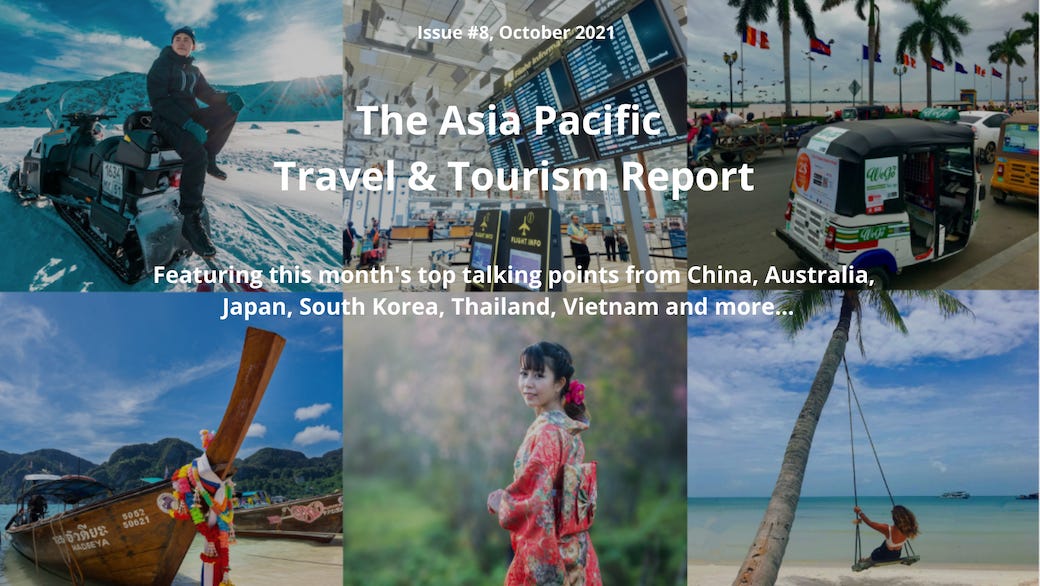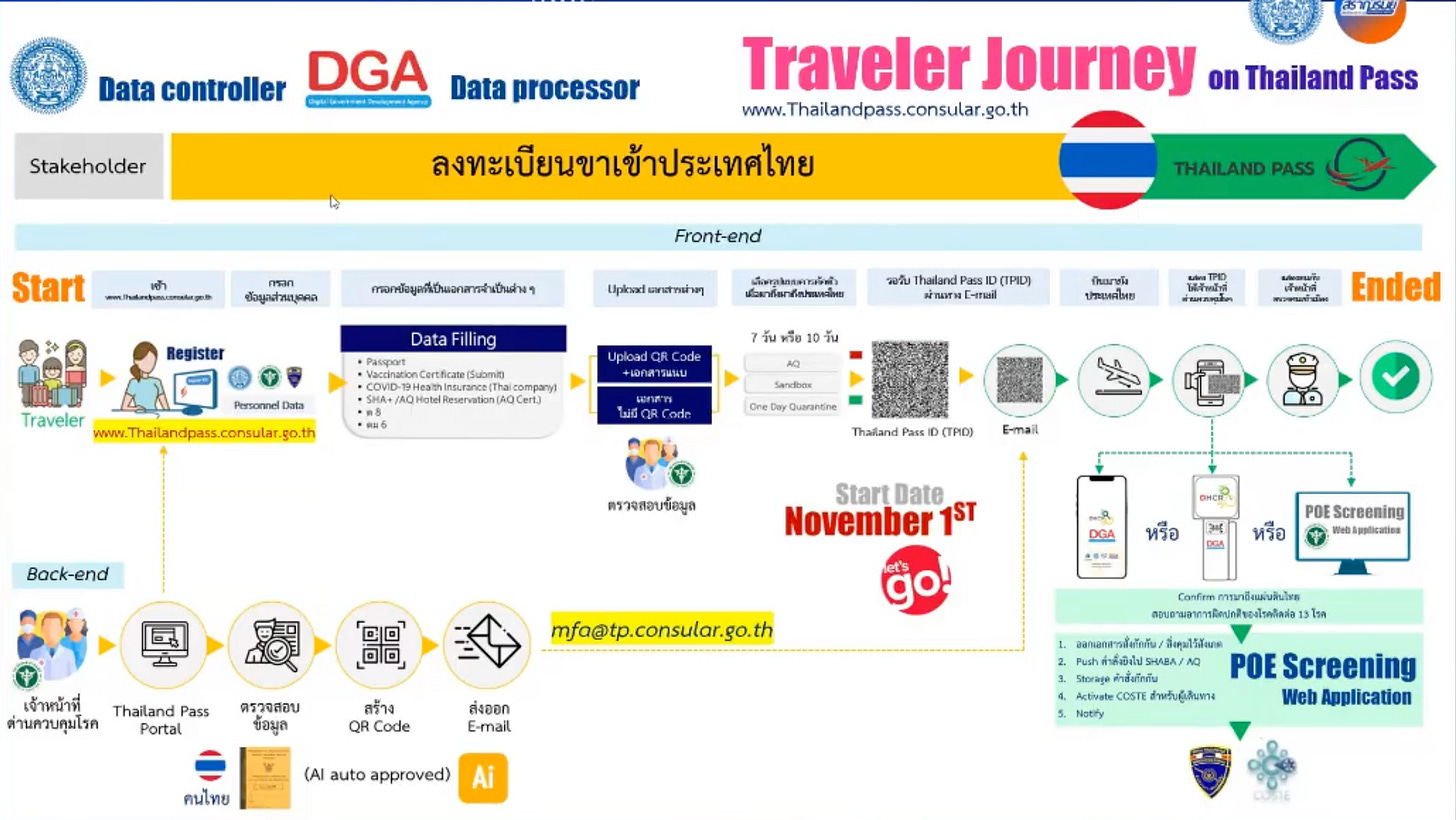Asia Pacific Travel & Tourism Report #8 - October 2021
10 top talking points as Australia and Thailand prepare to restart travel.
Hello. Welcome to the 8th Asia Pacific Travel & Tourism Report… which is co-produced with Dr Jaeyeon Choe.
Featured destinations this month include Australia, China, Japan, New Zealand, South Korea, Thailand and Vietnam.
If you like the report, please share it with a colleague by using the button below.
Thanks for being on board,
Gary
10 Top Talking Points in October 2021
Source: Thai Ministry of Foreign Affairs
1) Thailand Embraces Triple-Track Travel
Thailand is readying to reopen. The authorities confirmed that international tourists from 63 countries/territories can enter from 1 November.
Essentially, there are now 3 entry mechanisms (with a separate QR code for each) under the new Thailand Pass:
Exemption from Quarantine (Test & Go, 1 night stay - see: “quarantine hotel”)
Blue Zone Sandbox (7-day initial stay)
Alternative Quarantine (10 days)
17 “Blue Zone Sandbox Destinations” - including Bangkok, Krabi, Pattaya and Phuket - will initially welcome fully vaccinated visitors who must pre-book 7 hotel nights.
7 airports will be used: for the Test & Go and Sandbox schemes: Suvarnabhumi, Don Mueang, Chiang Mai, Phuket, Samui, U-Tapao and Buriram (charter flights).
Several challenges still exist. The above graphic, published on Friday by Thailand’s Ministry of Foreign Affairs, illustrates the administrative complexity that prevails.
Unlike Singapore or Malaysia, Thailand is not reopening after achieving a defined vaccine threshold. Its full vaccination rate is approx 52%. Hence, there are concerns about potential health risks for residents, tourism-facing workers and visitors.
The colour coding of ‘Covid Zones’ takes some studying. A good summary is here.
Thailand is forecasting 30,000 arrivals at Bangkok’s Suvarnabhumi International Airport on Monday.
*CLICK HERE to watch the Thai Ministry of Foreign Affairs Webinar, 29 October, which explains the 3 entry processes. Scroll to the English sections: 13.15-17.00 mins & 28.30-32.30 mins.
A list of the 63 eligible countries is HERE.
2) Fortress Australia Reconnects With the World
This week, Australia officially removed its “Do Not Travel” warning to all citizens. This signals a quarantine-free reopening for vaccinated travel from 1 November.
For the near term, Sydney (New South Wales) and Melbourne (Victoria) will be the focus of most flight activity. Other states will gradually join - and scale up - as they surpass stated vaccine thresholds.
CLICK HERE for the latest official advice on travel to/from Australia.
Ahead of Australia’s reopening, The South East Asia Travel Show spoke with Simon Westaway, former Executive Director of the Australian Tourism Industry Council.
In an insightful chat, Simon analysed the scale of pandemic decimation to Australia’s visitor economy - and explained how Australia’s reopening will likely unfold.
“From 1 November, it will be very much about fully vaccinated Australians returning to the country and people in Australia, be it resident citizens or people keen to get back to their home country, leaving. There’s a big backlog of overseas Australians needing to get home… but the situation could move pretty quickly.”
In terms of overseas travel:
“I think we’re going to see Australians travel outbound in really strong numbers in 2022… especially from the eastern seaboard cities. Airlines and wholesalers will be very aggressive to stimulate Australians to travel, and there is huge pent-up demand to get travelling again.”
Inbound travel:
“Inbound travel may be a more sobering conversation than outbound. The big issue is China, which was by far the biggest spending market, accounting for almost 1-in-5 visitors to Australia. Hopefully, 2023-24 will see a more balanced inbound-outbound recovery across the board.”
And domestic travel:
“Domestic tourism, incorporating intra-state and interstate travel, is huge. On any given day of the week, it accounts for about there-quarters of our visitor economy. That will probably stay about the same going forward.”
Where are Australian travellers booking, and which markets could drive inbound traffic over the next 12 months?
Find out more below…
CLICK HERE to listen to Part 3 of The South East Asia Travel Show’s Destination 2022 series, which assesses the travel outlook in hot-ticket destinations for South East Asian travellers. This week, we discuss Australia’s new landscape for inbound, outbound and domestic travel with Simon Westaway, former Executive Director of the Australian Tourism Industry Council.
Click to listen to Part 1: South Korea (with Jaeyeon), and Part 2: Bali
3) What is ‘Quality Tourism'?
As they plan to revive inbound tourism, South East Asian governments and tourism boards are aiming their pitches at ‘quality tourists’. This ‘dollar-driven’ approach features slightly different terminology.
For example: ‘high-quality tourism’ (Indonesia); ‘high-yield tourists’ (Malaysia); ‘high-end tourists’ (Cambodia) and ‘high value-low impact tourism’ (Thailand).
Indonesia’s Coordinating Minister recently said he would prefer backpackers didn’t return to Bali:
“We don’t want backpackers to come, so that Bali remains clean, where the people who come are of quality.”
This caused a backlash on domestic and international social media, leading to a retraction of the comment.
The Thai government explicitly stated it wants to attract wealthy investors, retirees and affluent tourists to increase the pace of economic recovery. Sandbox-style pilot tourism schemes in Malaysia and Cambodia are being similarly pitched.
This is a short-sighted strategy.
Backpackers and independent travellers ‘discover’ remote and rural destinations. This type of organic travel benefits small local and informal tourism businesses, which suffered heavily during the pandemic.
Tourists at luxury resorts often bypass the local economy and contribute to economic leakage. BUT, they are viewed as easier to monitor, manage - and leverage.
While restructuring from mass tourism to a more sustainable, environmentally concerned form of travel is laudable - is that actually the ‘quality’ objective?
Watch this space…
4) Same, Same. Not Different.
While some governments outwardly focus on ‘high-yield’ tourists by abandoning budget travellers, little thought capital is flowing to transform the industry.
Since the pandemic started, there have been endless reports and articles about how the pandemic can be a vehicle for positive change - to make tourism environmentally, economically and socially sustainable.
This week, the UNWTO pledged to push this agenda (ahead of the COP 26 meeting).
More diversified thought is needed in South East Asia to develop planet-friendly tourism products and address shifting tourist expectations.
Building a sustainable tourism sector requires collaboration with various stakeholders, such as academics, NGOs, businesses, communities and travellers themselves.
While some innovative tourism programmes are emerging these are mostly initiated and funded by international development institutions, entrepreneurs and businesses.
Destination marketing, though, looks and sounds very similar to before.
For some time, New Zealand has challenged itself to make the tourism industry more sustainable, diverse and inclusive.
It is a debate that should be progressing in ASEAN.
CLICK HERE to read Issue #41 - 8 Reasons Why New Zealand May Be a Benchmark for the Future of Tourism
5) China & Hong Kong Align on Border Lockdowns
“If Hong Kong were to loosen the border controls… or adopt what other countries have done… to live with the COVID-19 virus, then the chances of resuming travel with the mainland will be reduced.”
Those were the words this week of Carrie Lam, Hong Kong Chief Executive, as she announced tighter travel rules. Hong Kong is aligning with China’s hard border policy as it prioritises quarantine-free travel with the mainland.
The phrase: “or adopt what other countries have done… to live with the COVID-19 virus” echoes Beijing’s Zero Tolerance position, which will disappoint reopening South East Asian destinations hoping to attract Chinese tourists.
China has confirmed that inbound spectators will not be permitted at the 2022 Winter Olympics & Paralympic Winter Games, which begin on 4 February.
Moreover, with sporadic COVID-19 outbreaks and winter closing in, it may be some time before China revises its border policy.
6) Is ASEAN Moving on Vaccine Recognition?
This week’s ASEAN Leaders’ Summit was highly eventful.
Myanmar’s military leader was excluded by the 9 other Association of South East Asian Nations members in a rare show of collective displeasure.
China and Australia were confirmed as Comprehensive Strategic Partners.
Strong messages were voiced by Indonesian President Joko Widodo, Thailand’s Prime Minister Prayut Chan-o-cha and, later, Philippine President Rodrigo Duterte - for ASEAN to speed up mutual recognition of vaccine certifications.
The goal is to revive intra-ASEAN travel, which accounted for around 52 million of the 143.5 million visitor arrivals into ASEAN in 2019.
So, is action on vaccine passports realistic before the 2022 ASEAN Tourism Forum in Sihanoukville in January?
The bloc machinery moves slowly. BUT, governmental mindsets are shifting towards restoring travel flows after 20 months of locked borders.
Officially, the post-meeting stance is:
“We welcomed the Post-COVID-19 Recovery Plan for ASEAN Tourism, which provides coordinated measures to be undertaken by Member States in a phased approach to safely reopen the industry while working towards a more sustainable, resilient and inclusive ASEAN tourism.”
Watch this space…
7) Under-par COVID Resilience in South East Asia
Not a great deal of analysis is required for the new edition of Bloomberg’s monthly COVID Resilience Index - which compares 53 countries worldwide.
Similarly to the previous month, South East Asian nations occupy 5 of the bottom 6 spots. Indonesia is 48th. Malaysia, Thailand, Vietnam & Philippines rank 50th-53rd.
Singapore plummeted from 20th to 39th this month - despite an 87.8% vaccination rate. Its slumping status is largely due to the still-low flight capacity.
South Korea (14th) is the highest ranked Asia Pacific nation, with Japan 16th and Hong Kong 21st.
Europe counts 8 of the top 10 spots, with UAE (3rd) and Chile (8th) preventing a clean sweep of the premium placings.
8) South Koreans Tee-off in Thailand
As South East Asian destinations start to reopen, South Koreans are responding by changing their travel preferences. Large numbers of honeymooners who had booked trips to Jeju island are cancelling and booking for South East Asian destinations.
One significant niche market is golf travel to Chiang Mai.
Domestic golf tourism proved popular in South Korea during the pandemic. As Thailand reopens on 1 November, golf tourists are booking for Chiang Mai. Jeju Air is organising golf tour packages from 5 November.
Demand for golf trips to South East Asia is expected to rise sharply in the coming (winter) months.
With full vaccination reaching 70% in South Korea, people are starting to ‘live with COVID.’ This is fuelling outbound bookings. Major travel agencies are launching charter flights to Bali, Phu Quoc, Kota Kinabalu and Chiang Mai in January 2022.
9) Going Solo in Japan
Dining alone is a widely accepted practice in Japan. However, while Japanese people have been complying with social distancing and stay-at-home requests, solo camping, solo hiking and solo trips have surged in popularity. Growth of businesses geared towards solo leisure activities could be helping reduce individual anxieties and social pressures, but does the ‘solo boom’ hide an underlying issue of loneliness?
10) Russians Migrate to Vietnam in Winter
Vietnam plans to reopen selected destinations for the Northern Hemisphere winter, including Kien Giang, Quang Nam, Da Nang, Quang Ninh and Khanh Hoa. Russian travellers, who traditionally flock to Thailand and Vietnam in winter are pre-booking cold-weather escapes to sunny Vietnamese beach resorts, such as Khanh Hoa.
And, that’s a wrap.
The Asia Pacific Travel & Tourism Report will return on 28 November.
The weekly Asia Travel Re:Set newsletter is back next Sunday. Here’s the most recent issue (#60) in case you missed it.
Have a great week,
Gary






